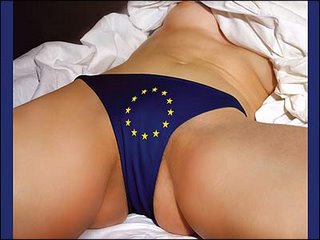This is just pants
 You will probably recognise the image on the left as one drawn from the recently launched Home Office anti-rape campaign on consent. There has been some interesting comment on the "messages" of this poster (and indeed the other campaign poster which you can find here, along with some Home Office explanations). Just a sample of the thoughts from Mind the Gap and Rhetorically Speaking will suffice to make the point. ...
You will probably recognise the image on the left as one drawn from the recently launched Home Office anti-rape campaign on consent. There has been some interesting comment on the "messages" of this poster (and indeed the other campaign poster which you can find here, along with some Home Office explanations). Just a sample of the thoughts from Mind the Gap and Rhetorically Speaking will suffice to make the point. ......"the horrible association made in the text between entering the woman sexually and entering a prison..." (MTG); a campaign which "seems more concerned with protecting men from accusations of rape than protecting women" (MTG); "this woman here is not represented as a person. She is reduced to her crotch, a nameless, faceless cunt which exists to be penetrated. How can we fight the objectification of women with .... the objectification of women? We need a campaign which asserts the personhood of all women" (MTG);..."the sanitisation of assualt that worries me, a clean passive headless white body" (RS);"... "Respect for the person you want to sleep with has been ignored for scare tactics" (RS).
There is nothing more I can add to these arguments (rightly lauded in Tim Worstall's BritBlog Roundup #57). They show - depressingly - that little appears to have moved on in relation to discussions about sexual violence since earlier waves of feminism in the 1970s and 1980s were trying to bring these issues to more prominent attention. The sad thing appears to be that - without any irony of purpose - public institutions have adopted these problematic images in order, ostensibly, to put across a message of respect.

When I initially saw the campaign poster, it put me in mind of something else I saw earlier this year which, I think, intended to be an ironic comment on a female body (the European Union - of the feminine gender in almost every European language I can think of) and the question of entry (i.e. enlargement). That is the image, here, of a woman in "Eurostar" panties in a sexually provocative position.
This is a photograph by Serbian artist Tanja Ostojic, part of an exhibition organised in Austria which to commission controversial artists to produce billboard posters which were displayed at the beginning of the Austrian EU Presidency at the beginning of this website. If you check out all the posters here you will see that this is hardly the most controversial of them. Controversy exploded quickly in Austria and many of the billboards were taken down, as the posters became known as the "porno-posters". However, unlike the Danish cartoons affair, a storm of campaigning for free speech didn't seem to be the result!
More background to the debate is provided here, on the Brussels Journal, which gives the following more detailed explanation of the poster and its link to "Europe":
"When the leftist Austrian art collective 25 Peaces recently approached the Austrian government with a proposal to have 75 European artists make a series of 150 posters celebrating Austria’s presidency of the European Union, it was no surprise that Ostojic, with her leftist feminist and Europeanist political ideas, was asked to participate. She presented a picture of a woman’s crotch dressed in briefs adorned with the EU flag. The work was clearly inspired by Gustave Courbet’s 1866 oil canvas of a vagina, entitled “The Origin of the World.” As one can imagine Courbet’s work, currently at the Musée d’Orsay in Paris, would have caused an uproar when exhibited in the 1860s, but it was never exhibited. Courbet’s painting was not government-funded, nor were people who did not want to see it confronted with it in the streets. In those days Europe was still, well, a civilized society, where artists could do as they pleased (at least if they provided for themselves) but certain sensitivities were respected in public."
How do we evaluate the sexual politics of this poster? Does it matter that it was composed and presented by a woman? By an artist? Is the irony lying behind what it expresses sufficient to offset the visual objectification of a woman's body and her vagina as a point of access in particular? And is that irony the precise point of differentiation from the contested Home Office "No Entry" poster?




0 Comments:
Post a Comment
<< Home